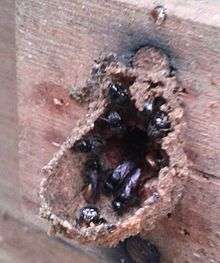Lestrimelitta
Lestrimelitta is a genus of stingless bees found in the Neotropics, from Mexico to Brazil and Argentina, with 19 known species . They are small, shining black species from 4 to 7 mm in length, with rounded heads and reduced pollen baskets. Unlike most eusocial bees, they do not gather their own pollen and nectar from flowers, thus are not pollinators, but instead they invade the colonies of other stingless bee species and rob their pollen and honey stores (a phenomenon called "cleptobiosis"). They do not initiate their own nests, but they will "evict" another stingless bee colony from its nest (usually in a tree cavity), and convert the pre-existing nest to house their own colony.
| Lestrimelitta | |
|---|---|
 | |
| Scientific classification | |
| Kingdom: | Animalia |
| Phylum: | Arthropoda |
| Class: | Insecta |
| Order: | Hymenoptera |
| Family: | Apidae |
| Tribe: | Meliponini |
| Genus: | Lestrimelitta Friese, 1903 |
| Species | |
|
24 spp. | |
Selected taxa
- Lestrimelitta catira(Gonzalez and Griswold, 2012)
- Lestrimelitta chacoana(Roig-Alsina, 2010)
- Lestrimelitta chamelenis(Ayala, 1999)
- Lestrimelitta ciliata(Marchi and Melo, 2006)
- Lestrimelitta danuncia(Oliveira and Marchi, 2005)
- Lestrimelitta ehrhardti(Friese, 1931)
- Lestrimelitta glaberrima(Oliveira and Marchi, 2005)
- Lestrimelitta glabrata(Camargo and Moure, 1990)
- Lestrimelitta guyanensis(Roubik, 1980)
- Lestrimelitta huilensis(Gonzalez and Griswold, 2012)
- Lestrimelitta limao (Smith, 1863) –irati
- Lestrimelitta maracaia(Marchi and Melo, 2006)
- Lestrimelitta monodonta( Camargo and Moure, 1990)
- Lestrimelitta mourei(Oliveira and Marchi, 2005)
- Lestrimelitta nana(Melo, 2003)
- Lestrimelitta niitkib(Ayala, 1999)
- Lestrimelitta opita(Gonzalez and Griswold, 2012)
- Lestrimelitta rufa(Friese, 1903)
- Lestrimelitta rufipes(Friese, 1903)
- Lestrimelitta similis(Marchi and Melo, 2006)
- Lestrimelitta spinosa( Marchi and Melo, 2006)
- Lestrimelitta sulina( Marchi and Melo, 2006)
- Lestrimelitta tropica( Marchi and Melo, 2006)
gollark: You can actually overload operators easily with metatable hax; potatOS lets you divide and subtract strings.
gollark: Is it now.
gollark: (because people never strip the debug symbols)
gollark: (although that decompiles pretty easily)
gollark: I had to deal with BYTECODE before, you know.
References
- C. D. Michener (2000) The Bees of the World, Johns Hopkins University Press.
- J. S. Ascher, J. Pickering, (2012) Discover Life's bee species guide and world checklist
This article is issued from Wikipedia. The text is licensed under Creative Commons - Attribution - Sharealike. Additional terms may apply for the media files.